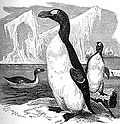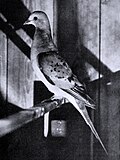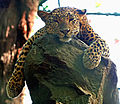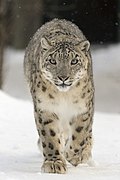Difference between revisions of "AY Honors/Endangered Species/Answer Key"
| Line 93: | Line 93: | ||
Sometimes exotic pets escape or are released into the wild when they are no longer wanted. This can have a negative impact on native species in the area. | Sometimes exotic pets escape or are released into the wild when they are no longer wanted. This can have a negative impact on native species in the area. | ||
| − | ==Habitat Restoration== | + | ===Habitat Restoration=== |
*Hold an Arbor Day tree-planting party. | *Hold an Arbor Day tree-planting party. | ||
*Restore a riverbank by replanting native species (under proper an knowledgeable supervision) and picking up litter. | *Restore a riverbank by replanting native species (under proper an knowledgeable supervision) and picking up litter. | ||
Revision as of 05:58, 22 March 2006
Endangered Animals
Skill Level 2
Approved 2/2005
North American Division
2001 Edition
1. Define the following terms:
- Endangered
- A species that has almost gone extinct.
- Extinct
- A species that has died out completely. When the last specimen dies, that creature is said to have become extinct.
- Habitat
- A specific place or the natural conditions in which a given species lives.
- Biome
- Any major regional biological community such as that of forest or desert.
- Food chain
- A food chain describes a single pathway that energy and nutrients may follow in an ecosystem. They usually start with a primary producer and end with a top predator. Here is an example of a food chain:
- phytoplankton → copepod → fish → squid → seal → Orca
- This "chain" can be described as follows: Killer whales (Orca) feed upon seals, that feed upon squid, that eat small fish, that feed on copepods, that feed on microscopic algae.
- Poacher
- A person who illegally hunts an animal in order to kill it.
2. Write Genesis 1:28 in your own words.
Genesis 1:28 is presented below in several translations. It might help to have your group read several versions of the text before they attempt to put the verse in their own words.
- NIV
- God blessed them and said to them, "Be fruitful and increase in number; fill the earth and subdue it. Rule over the fish of the sea and the birds of the air and over every living creature that moves on the ground."
- NKJV
- Then God blessed them, and God said to them, “Be fruitful and multiply; fill the earth and subdue it; have dominion over the fish of the sea, over the birds of the air, and over every living thing that moves on the earth.”
- CEV
- God gave them his blessing and said: "Have a lot of children! Fill the earth with people and bring it under your control. Rule over the fish in the ocean, the birds in the sky, and every animal on the earth."
- NASB
- God blessed them; and God said to them, "Be fruitful and multiply, and fill the earth, and subdue it; and rule over the fish of the sea and over the birds of the sky and over every living thing that moves on the earth."
3. List four factors that have caused animals to become endangered.
Habitat loss
The most common threat to endangered animals is the destruction of their natural habitat. Deforestation one way that habitat is destroyed. Rain forests are cut down for many reasons, including the sale of lumber, clearing for agriculture, or gathering wood for fuel. Human encroachment into wild areas for development of agriculture, industry, and housing is another common cause for species endangerment. Building dams can prevent many species of fish from swimming upstream to spawn, and this disrupts their lifecycle. The construction of pipelines has a similar effect on land animals, preventing predators from accessing areas containing their prey, or isolating animals from other members of their species, thus reducing the amount of genetic material available to the population as a whole.
Invasive species
Ever since man gained he ability to travel long distances, he has brought along with him other species. Sometimes this was intentional, as in livestock, and other times unintentional, as in rats boarding a ship. Whether intentional or not, the effect is often the same: the extinction of native species in the newly entered region. The reason invasive species cause such harm is because they often have no natural predators in the region, or they out-compete a native population for resources. Examples of endangerment due to the introduction of invasive speciesto North America include the chestnut blight (caused by an Asian sac fungus) and dutch elm disease (caused by the elm bark beetle). Both of these occured in the early 20th century. A more recent threat has been the introduction of the emerald ash borer (another beetle), which is threatening ash trees in North America.
Trees are not the only species that are threatened by invasive species. Other examples abound.
Poaching
Many animals are endangered because of poaching. Elephants are killed for their ivory. Rhinoceroses are killed for their horns. Bears are killed for their gallbladders. Tigers and other large cats are killed for their skins.
The dodo was an animal hunted to extinction by european hunters. It wasn't long after Dutch colonists settled on the island of Mauritius in the 17th century that the hapless dodo was driven extinct. Since then, dodo researchers haven't had much to work with other than a handful of composite skeletons in museums and anecdotal reports from early mariners. More has been written about this bird than practically any other, yet researchers practically know nothing about it.
Pollution
Pollution can kill off a species very rapidly, by killing all living members through contamination or sterilizing them. It can also occur over longer periods at lower toxicity levels by affecting life span, reproductive capacity, or competitiveness. DDT played such a role in killing off bald eagles and other birds by thinning the egg shell walls of affected birds, thus lowering the survivability of offspring. Since this effect was discovered, DDT has been banned in many parts of the world and affected bird populations are recovering.
4. Name four animals that are now extinct.
- Steller.gif
Steller's Sea Cow, 1768
5. List four things that are being done to save endangered animals.
Endangered Species Act for the USA
Environmental Preservation Laws
6. List four activities you can do to help wild animals.
Raise Awareness
The more people are aware of the problems faced by endangered animals, the more they are likely to do something about it. Here are some suggested ways you and your club can help to raise awareness of endangered species:
- Make a "Save the Animal" poster and display it.
- Have a panel discussion Endangered Species vs Development.
- Make a bulletin board display.
- Make an Endangered Species craft project.
Sustainable Use of Resources
One of the more obvious things to do is to refuse to purchase items made from endangered animals, such as ivory. Even though the trade in these items poses a significant threat, there are more subtle things that we do that has an even greater impact. We are not often faced with the option of purchasing a tiger skin or an ivory trinket, but we are often tempted to engage in other behaviors which are just as destructive.
Reduce your consumption levels. Today's rate of consumption of natural resources is unsustainable. Consumption of goods puts a stress on the environment, as ultimately, that is where all raw materials come from. Avoid purchasing disposable items, and buy reusable items instead.
Boat Inspections
If you own a boat or a personal watercraft, it is important to inspect it before you tranport it etween different waterways. Zebra muscles are an invasive species that is currently spreading west in the United States and Canada, and these creatures spread by "hitching a ride" on boats that are transported between non-interconnected waterways. Inspecting your boats and removing all wildlife from them can help prevent the spread of invasive species.
Exotic Animals
Do not buy or keep exotic animals. The snakehead fish became infamous in the US because of their appearance in a pond in Crofton, Maryland in 2002. They are prohibited in several other countries like Australia because their introduction to new ecosystems may displace indigenous species. Humans have been introducing snakeheads to non-indigenous waters for over 100 years. In parts of Asia and Africa, the snakehead is considered a valuable food fish and is produced in aquacultures. Due to this fact it was introduced either on purpose (fisheries motivation) or by ignorance (as was the case in Crofton).
Sometimes exotic pets escape or are released into the wild when they are no longer wanted. This can have a negative impact on native species in the area.
Habitat Restoration
- Hold an Arbor Day tree-planting party.
- Restore a riverbank by replanting native species (under proper an knowledgeable supervision) and picking up litter.
- Plant a garden at your school, church, or home to attract wild birds and butterflies.
Data Gathering and Monitoring
- Adopt a stream, wetland, or other waterway. Monitor which species use the area and try o get an idea of how many individual animals are involved. Distribute your findings.
- Participate in the Christmas bird count, a birdathon, or in a Feeder Watch.
7. List ten endangered animals. Tell where they live and why they have become endangered.
When teaching this honor to a group, you could go to the library ahead of time and check out several books on the various endangered animals, or on endangered animals in general. You will need enough books so that each Pathfinder can have one (or they could share them in groups of two), and you need to make sure that you have information on at least ten endangered animals. You could instead bring in a set of encyclopedias. During class, pass the books around and have each Pathfinder look up the information on the animal featured in that book. It is important that the Pathfinders do this research themselves rather than having it handed to them. Below are some well-known endangered mammals (although mammals are not the only type of endangered animals).
- Orangutan 001.jpg
Orangutan
8. Do two of the following activities:
a. Visit a zoo or animal preserve that has one or more endangered animals in residence. List what animal(s) you saw, where they normally live, and why they have become endangered.
This activity is probably the one that your Pathfinders will enjoy the most. If you choose to do this one and activity 'b', try to do activity 'b' first, as that will make this one more educational.
If you choose to do this activity in conjuction with activities 'c' or 'd', do this activity first so that the Pathfinders may use the trip to the zoo to gather materials and information.
b. Watch a video about an endangered animal. List what animal(s) you saw, where they normally live, and why they have become endangered.
Below is a list of videos you might be able to use. These have not been reveiwed by the authors of this answer book so you may want to screen them before showing them to your Pathfinders. If you have seen any of these, please edit this section with a review.
- Save the Endangered Species Series Choices Inc, Released October 1, 2002. Run Time: 150 minutes
- National Geographic's America's Endangered Species: Don't Say Good-Bye National Geographic Home Video, Released June 9, 1998. Runtime: 60 minutes
- NOVA: Shadows of the Condor WGBH Educational Foundation. Run Time: 60.0 minutes
c. Choose an endangered animal and write or give orally a short report about it. Tell where it normally lives, why it has become endangered, what is being done to save it, and any other special details about this particular animal that you have learned.
You may wish to do this activity after doing activity 'a' or 'b', as both of those will allow your Pathfinders to gather information, materials, and inspiration for completing thier reports.
d. Make a scrapbook about endangered animals. This may include newspaper articles, stories, pictures, stamps, or drawings. This may be a group project.
If you choose this option, be sure to look over the Scrapbooking Honor as well, as this activity could be used to meet requirement 9. This option works best when completed after doing activity 'a'. Be sure to have your Pathfinders each bring a camera (disposable camera work well for this) to the zoo and take plenty of pictures. Remind them that they should reserve their film for endangered animals. Also, if they are going to complete the Scrapbooking Honor as well, they will need enough material for 12 pages.
This option can be also completed without a trip to the zoo by using magazine clippings, drawings, or photographs downloaded from the Internet, etc.
e. Do an environment circle.
With a group of 10-20 persons, form a loose circle with people evenly spaced within. Have each person represent something in the environment such as animals, grasslands, forests, etc. Then take a spool of heavy thread or string and connect each person to others in the circle. Have the leader start cutting the connections and start taking individuals out of the circle and see how the remaining persons are affected by the loss. Help the group to see that each thing in nature is very necessary to the survival of everything else in nature.


























